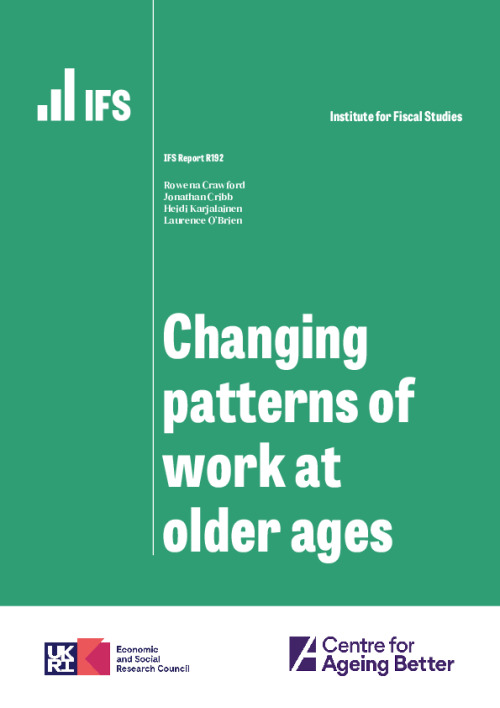Longer working lives offer many benefits, but achieving these can pose challenges for individuals, employers and policymakers. In order to support people in their 50s and 60s to remain in paid work for longer, it is imperative that we have a good picture of what paid work looks like at older ages, and how that might evolve in future. The desired working patterns of older workers – in terms of their hours of work, the form of their employment or the tasks they undertake at work – may be quite different from those of middle-aged or younger adults.
An ageing population and higher employment rates for people in their 50s and 60s mean that patterns of work of older workers are an increasingly important issue for the country as a whole. Indeed, in 2019, around 10 million or 61% of 50- to 69-year-olds were in paid work, meaning that this age group comprises almost a third (31%) of the workforce in the UK, up from just 21% in 1992.
In this report, we provide fresh evidence on the nature of paid work at older ages, how employment patterns differ for people in different circumstances and how the situation is changing over time. In particular, we examine in depth the transitions that older workers make, both into and out of work and between different types of employment in the run-up to retirement.
Having provided a comprehensive picture of working life for people in their 50s and 60s, we then examine the implications of our findings for some key issues facing older workers in the labour market in the coming years, including which groups might be of particular concern in the wake of the COVID-19 pandemic. These issues are important not only for the individuals themselves, but for policymakers who are seeking to encourage people into longer and more fulfilling working lives, for employers who would benefit from employing them, and for civil society organisations and government agencies interested in assisting older people in finding productive work that allows them to balance their work and personal lives.
Key findings
- There are likely to be significant challenges for many people in their 50s and 60s finding new jobs after the end of the furlough scheme. Older workers, particularly those aged over 65, have been more likely to be furloughed than middle-aged workers – at the end of April 2021, 14% of workers over 65 were furloughed, compared with 10% of those aged 40–49. There may well be significant numbers of older jobseekers in coming months.
- There are a number of reasons that finding new work may be challenging for people in their 50s and 60s. Most older workers do not have much recent experience of searching for work: Over two-thirds (69%) of 55-year-old workers have been with their employer for more than five years. Only 4% of older workers typically change employer in a single year. Older workers are also less likely than younger workers to change occupation, which may be necessary if vacancies are not available in their current line of work – and this is something that could become more prevalent as the economy adjusts to new patterns of working and spending after the pandemic.
- Older jobseekers from lower socio-economic groups are more likely to struggle to find new work after a period of unemployment. Those with lower levels of education, the long-term unemployed and women are particularly less likely to re-enter work at older ages after becoming unemployed.
- Significant numbers of older workers would benefit from lower hours of work and more flexibility. 16% of 50- to 69-year-olds in employment would like to work fewer hours, up from around 14% prior to the Great Recession. That is an increase of around 230,000 people. People in their 60s, those who own their home outright, those reporting a limiting health condition, and those who have been in their current job for longer are particularly likely to want to work less.
- For some older workers, part-time work acts as a way of making a gradual transition towards retirement. Moving into part-time work at older ages is more common amongst people with higher levels of education and living in less deprived areas – which could point to differences in access to part-time work or to differences in financial constraints that affect people’s ability to reduce their hours.
- Only 9% of older employees become self-employed in the run-up to retirement. Transitions into self-employment are more likely among men and those with a history of self-employment earlier in life. Given self-employment is a form of flexible work where people have greater autonomy over their hours, policymakers should consider whether older workers could be encouraged to view the option of being self-employed as a way of extending their working life.
- Half of full-time workers move straight into non-working retirement, without any intermediate steps. One particularly important factor predicting moving straight from full-time work to retirement is membership of a defined benefit pension – those with such a pension are 13 percentage points (ppts) more likely to go straight from full-time work to retirement than those without. These pensions are particularly common in the public sector. As the reforms to public sector pension arrangements have led to a reduction in the financial disincentives associated with working shorter hours before retirement, public sector employers should consider how best to support employees who want to move gradually into retirement.
- There is a small but important section of the older workforce who would like to work more hours. Around 7% of older workers in 2019 wanted to work more hours per week, higher than the 5% seen in 2007 before the financial crisis. That is an increase of around 190,000 individuals. They tend to have less secure work arrangements, such as being on a temporary employment contract. They are more likely to have low earnings and shorter job tenures, be in their 50s rather than their 60s, be men and be working part-time. The self-employed are also more likely to want to work more hours, highlighting that the flexibility of self-employment also entails risks.
- The position in the labour market of people in their 50s and 60s with long-standing health conditions requires special attention. Around 49% of people (and 39% of workers) aged 50–69 report a long-standing health problem. Older workers with long-term and work-limiting health problems are 5 ppts less likely to be in paid work in a year’s time than are similar workers without such a health problem. Those in work with a health problem are also significantly more likely to retire via a period out of the labour market.
- Some people in their 50s and 60s with long-standing health problems may have preferred, and been able, to stay in work if they had more flexibility or better support. Indeed, those with a health problem are around 4 ppts more likely to want shorter hours than those without a health problem.
- The working lives of men and women who are approaching retirement over the next decade will be very different from those of people who did so over the last decade. In future, those approaching retirement are increasingly likely to be in more stressful and more cognitively demanding jobs. Currently, older workers in these sorts of jobs are significantly more likely to want to work shorter hours but are actually less likely to move into part-time roles. This suggests that making sure appropriate flexible work options are available to this group should be a particular priority in the years to come.














